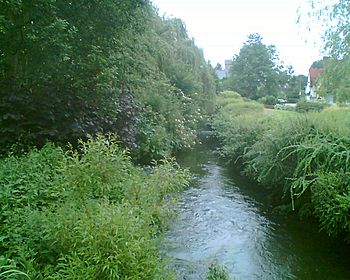River Wye, Buckinghamshire facts for kids
Quick facts for kids Wye |
|
|---|---|

River Wye near Wooburn Industrial Estate
|
|
| Country | England |
| Counties | Buckinghamshire |
| Towns | High Wycombe, Bourne End |
| Physical characteristics | |
| Main source | West Wycombe, Chiltern Hills 94m 51°38′52″N 0°48′45″W / 51.64778°N 0.81250°W |
| River mouth | River Thames Bourne End 26m 51°34′13″N 0°42′40″W / 51.57028°N 0.71111°W |
| Length | 14 km (8.7 mi) |
| Discharge (location 2) |
|
The River Wye is a small but important river in Buckinghamshire, England. It is about 9 miles (14 kilometers) long. The river starts near the village of West Wycombe in the Chiltern Hills.
From its source, the River Wye flows through the town of High Wycombe. It then joins the famous River Thames at Bourne End. Sometimes, after a lot of rain, the river's starting point can move. A chalk spring further up the valley can begin to flow, making the river seem longer.
The town of High Wycombe gets part of its name from this river. Today, much of the River Wye flows underground as it passes through the town. Pann Mill is a historic watermill located at the eastern end of High Wycombe. It is the last watermill still standing on the River Wye.
Contents
River Wye: A History of Watermills
The Wye Valley has a long and interesting history of using water power. The river drops about 220 feet (67 meters) over its 9-mile (14-kilometer) journey. This drop made it perfect for powering watermills.
Early Mills and Their Uses
Long ago, in 1086, a book called the Domesday Book was written. It recorded that there were eighteen watermills along the River Wye. These mills were spread out between West Wycombe and the River Thames.
By the 1600s, there were different types of mills. Some were fulling mills, which cleaned and thickened cloth. Others were corn mills, used to grind grain into flour.
The Rise of Paper Mills
In 1627, a survey listed several mills along the river. These included paper mills, which were becoming very important. Two early paper mills were Glory Mill in Wooburn Green and Hedge Mill in Loudwater.
By the mid-1600s, more paper mills opened. Paper was made from old rags back then. By the late 1700s, over 150 people in the valley worked as papermakers.
Peak of Papermaking and Changes
In 1816, papermaking was at its busiest in the Wye Valley. There were 32 paper mills, some of which also ground corn. Four mills only ground corn, and one was also a saw mill.
However, new technology changed everything. The Fourdrinier machine was invented. This machine could make a continuous roll of paper, which was much faster. This led to many people losing their jobs. Many families moved away to find work in cotton mills. In 1830, there were protests where people broke the new machines. Some people involved were sent to Tasmania.
Paper production continued at some mills, like Soho and Glory, until the late 1900s. These mills eventually switched from water power to steam power in the mid-1800s. The Soho mill was known for making high-quality colored paper until it closed in 1984.
Images for kids


